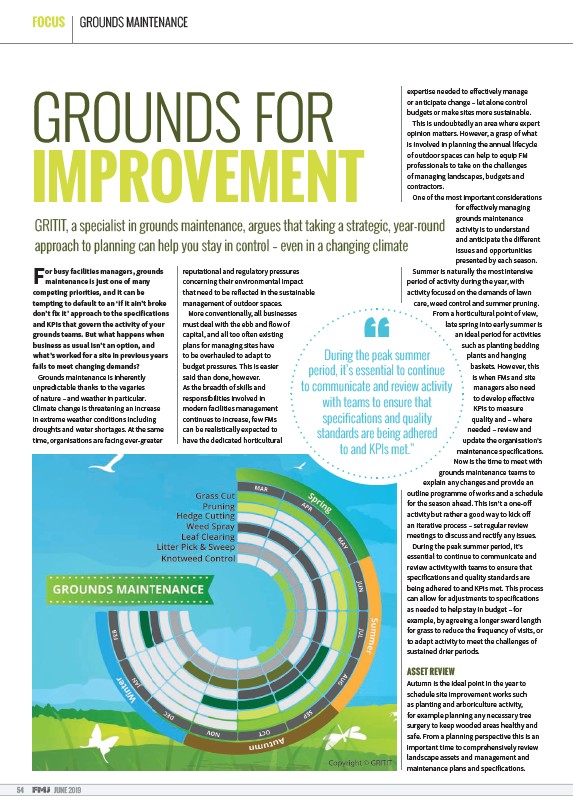
FOCUS GROUNDS MAINTENANCE
GROUNDS FOR
IMPROVEMENT
GRITIT, a specialist in grounds maintenance, argues that taking a strategic, year-round
approach to planning can help you stay in control – even in a changing climate
For busy facilities managers, grounds
maintenance is just one of many
competing priorities, and it can be
tempting to default to an ‘if it ain’t broke
don’t fix it’ approach to the specifications
and KPIs that govern the activity of your
grounds teams. But what happens when
business as usual isn’t an option, and
what’s worked for a site in previous years
fails to meet changing demands?
Grounds maintenance is inherently
unpredictable thanks to the vagaries
of nature – and weather in particular.
Climate change is threatening an increase
in extreme weather conditions including
droughts and water shortages. At the same
time, organisations are facing ever-greater
54 JUNE 2019
reputational and regulatory pressures
concerning their environmental impact
that need to be reflected in the sustainable
management of outdoor spaces.
More conventionally, all businesses
must deal with the ebb and flow of
capital, and all too o en existing
plans for managing sites have
to be overhauled to adapt to
budget pressures. This is easier
said than done, however.
As the breadth of skills and
responsibilities involved in
modern facilities management
continues to increase, few FMs
can be realistically expected to
have the dedicated horticultural
expertise needed to e ectively manage
or anticipate change – let alone control
budgets or make sites more sustainable.
This is undoubtedly an area where expert
opinion matters. However, a grasp of what
is involved in planning the annual lifecycle
of outdoor spaces can help to equip FM
professionals to take on the challenges
of managing landscapes, budgets and
contractors.
One of the most important considerations
for e ectively managing
grounds maintenance
activity is to understand
and anticipate the di erent
issues and opportunities
presented by each season.
Summer is naturally the most intensive
period of activity during the year, with
activity focused on the demands of lawn
care, weed control and summer pruning.
From a horticultural point of view,
late spring into early summer is
an ideal period for activities
such as planting bedding
During the peak summer
period, it’s essential to continue
to communicate and review activity
plants and hanging
baskets. However, this
is when FMs and site
managers also need
to develop e ective
KPIs to measure
quality and – where
needed – review and
update the organisation’s
maintenance specifications.
Now is the time to meet with
with teams to ensure that
specifi cations and quality
standards are being adhered
grounds maintenance teams to
explain any changes and provide an
to and KPIs met.”
outline programme of works and a schedule
for the season ahead. This isn’t a one-o
activity but rather a good way to kick o
an iterative process – set regular review
meetings to discuss and rectify any issues.
During the peak summer period, it’s
essential to continue to communicate and
review activity with teams to ensure that
specifications and quality standards are
being adhered to and KPIs met. This process
can allow for adjustments to specifications
as needed to help stay in budget – for
example, by agreeing a longer sward length
for grass to reduce the frequency of visits, or
to adapt activity to meet the challenges of
sustained drier periods.
ASSET REVIEW
Autumn is the ideal point in the year to
schedule site improvement works such
as planting and arboriculture activity,
for example planning any necessary tree
surgery to keep wooded areas healthy and
safe. From a planning perspective this is an
important time to comprehensively review
landscape assets and management and
maintenance plans and specifications.